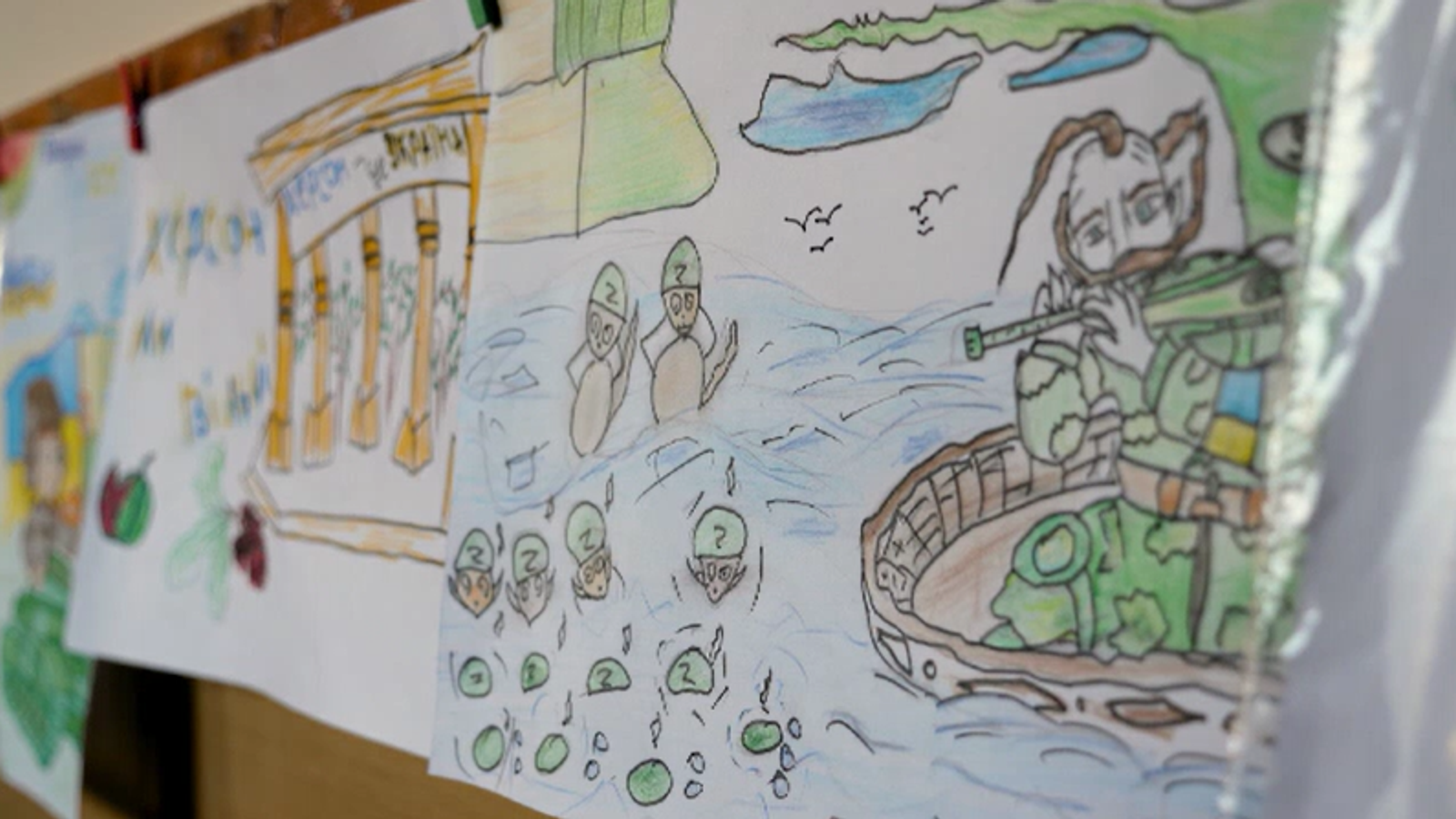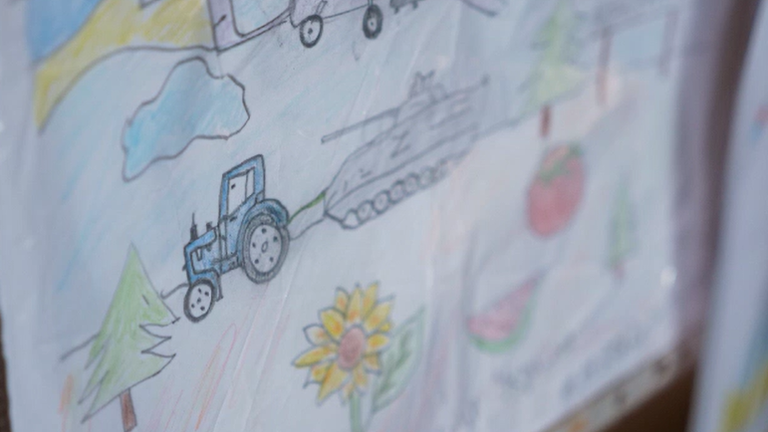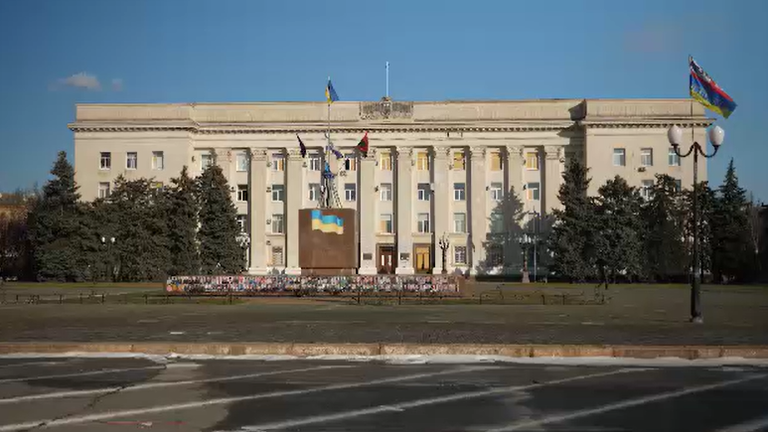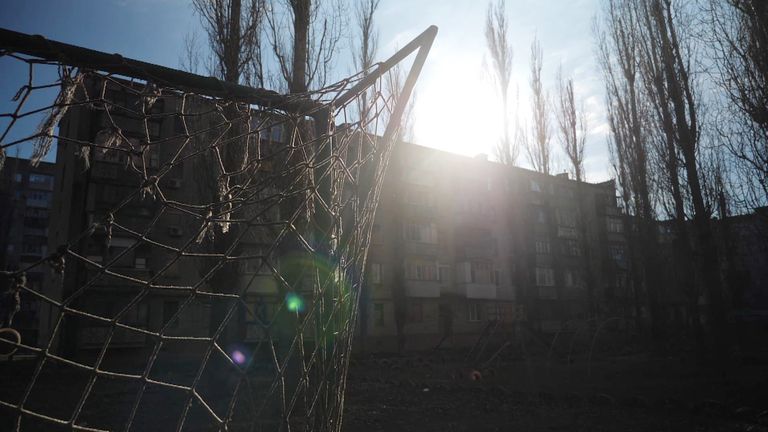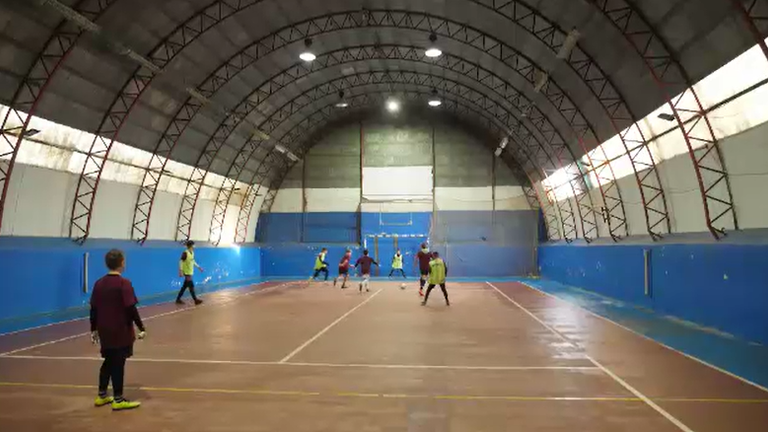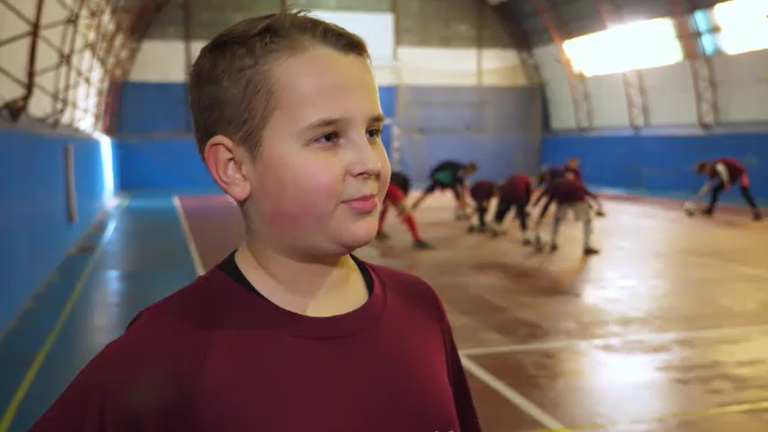Invading Russian troops – arms up, faces scared – drown in a river in the frontline city of Kherson as a Ukrainian soldier watches on, rifle raised.
The image, drawn by a child, is among a line of pictures, including of jets, tanks and corpses, that illustrates Ukraine’s lost childhood after almost two years of full-scale war.
They hang on a wall inside a school – shut for normal lessons – where a charity offers support to the dwindling number of children in Kherson whose parents have yet to flee.
One six-year-old boy, looking at the sketches, says his favourite is of a large Ukrainian tank.
Ukraine war latest: Plane ‘downed in act of terrorism’
“I like tanks,” says Ivan Rozsoha, clutching the hand of his grandmother, who brings him to the school for speech therapy.
The little boy, dressed in a puffy winter coat and a woolly hat, says it is scary when Russian troops launch artillery, drone and missile strikes against his city – a daily occurrence.
“When rockets fall, I try to hide my head under my toys,” Ivan says, gesturing with his hands.
He wants to become a soldier when he grows up and thinks Russia is bad, saying: “They are destroying Ukraine and I know how to destroy them.”
Zina Rozsoha, 67, his grandmother, appears distressed to hear such heavy thoughts from a child. Asked how she feels, she just says: “Tears.”
The speech therapy takes place in a classroom with more than a dozen other children, aged around four to seven, sitting at tables, clutching crayons and coloured pencils.
Anastasia Andryushchenko, a therapist, encourages them to express themselves through art, by drawing sad and happy faces, and then to explain why they have chosen these expressions.
She says a growing number of children in Kherson struggle with speech. Some no longer talk at all, terrorised by the fighting and with little chance to socialise.
“War has affected them profoundly in terms of their mental health,” the therapist says.
She adds: “In the last lesson, we were drawing Christmas trees with the children.
“Everyone had to draw a Christmas tree from their imagination. A lot of children drew a Christmas tree with explosions, with grenades. There was even a nuclear Christmas tree, which soldiers were defending.”
Loss of innocence
The loss of innocence is hardly surprising given everything that Ukraine’s children have endured since Russia launched its full-scale invasion on 24 February 2022.
Russian troops occupied Kherson, in southern Ukraine, from the early days of the war. Ukrainian forces managed to push them out just over eight months later.
However, efforts to surge deeper into Russian-held territory have faltered and the frontline remains on the eastern side of the Dnipro river that marks the southern edge of the city.
Air raid sirens and artillery are the soundtrack for the few thousand children who still live in Kherson – their parents unwilling or unable to leave.
Schools and nurseries are shut, so all lessons take place online at home – whenever there is power and an internet connection.
In a small, single-storey house on a modest residential street, six-year-old Yeva Lykhenko plays alone with her doll house in her bedroom – it is too dangerous to play outside.
The fair-haired girl with a shy smile does not like online learning and rarely has the chance to mix with other children.
“She does not have a childhood. They just took it away,” says her mother, Emma Lykhenko, 37.
Read more from Sky News:
At least 18 killed as Russia carries out air strikes
Two high-value Russian planes ‘shot down’, Ukraine claims
At night, Yeva is often kept awake by explosions.
“When it is very loud, I always come to her and say: ‘Do not be afraid, mummy is with you’,” the mother says.
“I try not to show I am worried or nervous, but inside I am just praying.”
The mother says she does not want to move away, in part because of the cost but also because there is no guarantee that other cities would be completely safe.
“I am telling myself all the time: just a little bit longer and victory will happen,” she adds.
Rare access to the most dangerous part of Kherson
Sky News has been given rare access to an island that lies between the two banks of the Dnipro river.
It is effectively a dividing line between Ukrainian and Russian troops, though further along some Ukrainian forces have made it across to the east bank amid fierce fighting.
The island is the most dangerous part of Kherson. Yet a few families, with young children, still live here as well.
We approach some dreary-looking, concrete apartment blocks that frame an empty playground of rusty climbing frames and swings in a residential section of the island.
On the ninth floor of one of the buildings, a young couple live with their two small daughters, Varvara, two, and Arina, who is just 18 months old.
Their apartment is tiny, filled with blankets and cushions to keep the family warm whenever the power cuts off – it has just come back on when we meet them after a three-week outage following an attack on a local energy facility.
The temperature outside is freezing.
The mother, Anastasia Tatarinova, who looks to be in her early 20s, says life is hard and the threat from Russian forces is growing.
“There are very huge explosions,” she says, sitting on a sofa and cuddling her youngest child on her lap.
“Yesterday there was a drone flying overhead. It is really worrying. All the time we are stressed.”
She was pregnant with Arina when the full-scale invasion started. The little girl, her hair pulled into a mini ponytail on the top of her head, has known nothing but war.
“She heard bombing from my tummy so has never seen normal life,” Ms Tatarinova says.
“We are afraid to play on the playground so we are staying home. It is very dangerous outside because there is shelling all the time.”
Asked whether the family will leave if the situation worsens, she says: “If it continues like that, of course, why would we stay here? We will have no choice then.”
Click to subscribe to Ukraine War Diaries wherever you get your podcasts
Football ‘too important’ to surrender
Despite the danger, some children back towards the centre of Kherson are still clinging to one passion – football.
Boys take aim towards a goal inside a well-used sports hall in a metal hanger with a curved roof, tucked in between residential blocks and deserted market stalls.
A coach blows a whistle as the children race around, kicking footballs.
Sitting in a changing room pulling up his sports socks, 12-year-old Rostislav Semenyuk says his dream is “to become a second Lionel Messi”.
He would also like to be a politician when he grows up.
The boy says he can barely remember what life was like before the war.
Asked if he can think of anything that he misses, he says: “More games – football games. There are fewer matches now.”
The head football coach says his boys and girls – the girls are due to train the next day – are not able to play matches in the Kherson region because it is too risky.
Instead, they travel to areas further away from the frontline to take on other teams.
Vyachslav Rol says the opportunity to train is “very important”.
“Children are suffering from the war so they need to distract themselves,” the coach says.
“The only opportunity for them to communicate with each other is at our training.”
A second boy, in a maroon-coloured kit, says football is his life.
“I love to train,” says Kyrylo Tsyvilskiy, 12, taking a brief pause to chat.
“My dream is I want my friends to come back, for the war to be over and for all these Russians never to exist.”
The post ‘They took her childhood away’: Inside a Ukrainian school shut by war where children’s drawings of conflict line the walls appeared first on Patabook News .

